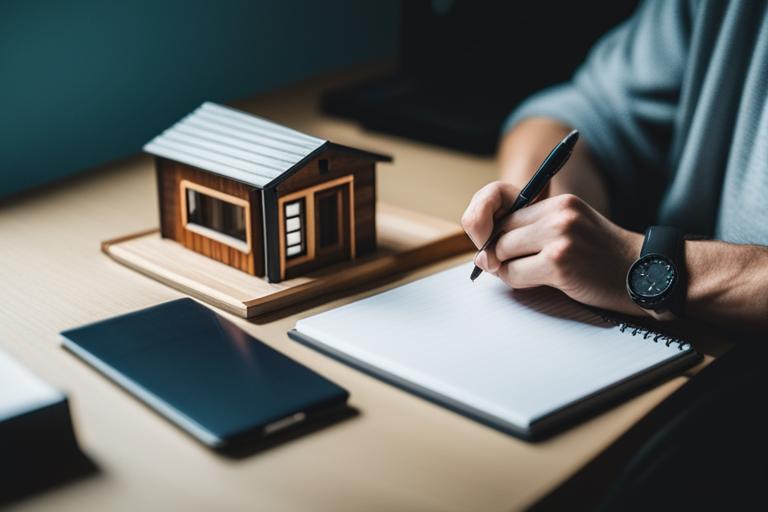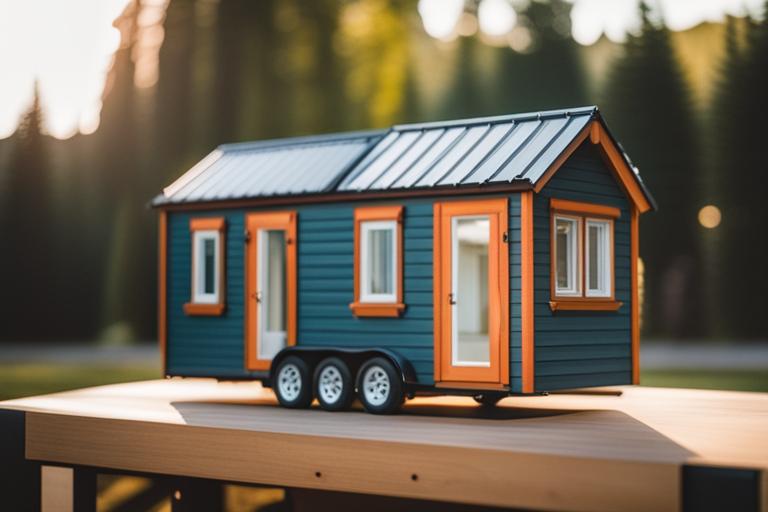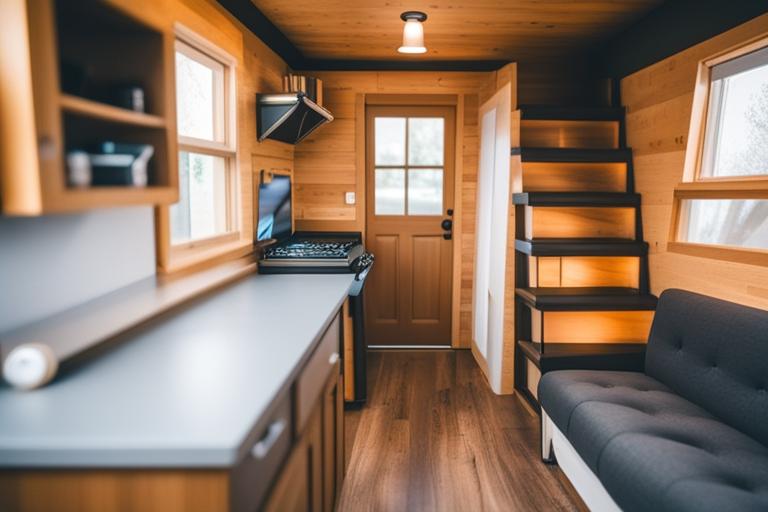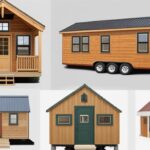What readers will learn by reading this article:
- Definition and benefits of using tiny house kits
- Factors to consider when planning and choosing a tiny house kit
- Step-by-step guide to assembling a tiny house kit
Building a home is an exciting and fulfilling experience, but it can also be a daunting task, especially when it comes to finding the right design, materials, and construction methods. That’s where tiny house kits come in. Tiny house kits are pre-designed and pre-cut packages that include all the necessary components to build a complete tiny house. Whether you’re a seasoned DIY enthusiast or a first-time builder, tiny house kits offer a convenient and cost-effective solution for creating your dream home.
A. Definition of Tiny House Kits
Tiny house kits are comprehensive packages that typically include pre-cut materials, hardware, and step-by-step instructions for constructing a small, fully-functional house. These kits are designed to simplify the building process and provide an efficient way to create a customized living space.
B. Explaining the Purpose and Benefits of Using a Kit
The purpose of using a tiny house kit is to streamline the construction process and make it more accessible to individuals with limited building experience. By providing all the necessary materials and instructions, kits eliminate the need for extensive research, planning, and sourcing of individual components.
C. Cost Savings, Convenience, and Customization Options Offered by Kits
One of the major benefits of using a tiny house kit is the cost savings it offers. Kits are often more affordable compared to traditional construction methods since they are mass-produced and utilize standardized materials. Additionally, kits eliminate the need to hire an architect or designer, further reducing costs.
Another advantage of using a tiny house kit is the convenience it provides. With a kit, all the components are conveniently packaged and delivered to your doorstep, saving you time and effort in sourcing materials. The instructions included in the kit guide you through the construction process, ensuring a smooth and efficient build.
Moreover, tiny house kits offer a range of customization options. While the basic structure is provided by the kit, you have the freedom to personalize the interior layout, finishes, and additional features to suit your preferences and lifestyle. This allows you to create a unique and functional living space that reflects your individuality.

Research and Planning for Tiny House Kits
Before embarking on your tiny house project, it’s crucial to conduct thorough research and planning to ensure a successful and satisfying outcome. Consider the following factors to make informed decisions and set realistic expectations.
A. Factors to Consider Before Starting a Tiny House Project
1. Budget Planning for Purchasing a Kit
Determining your budget is the first step in any construction project. Research different tiny house kits and their associated costs to get an idea of the price range. Keep in mind that the kit cost is just one component of the overall budget; you’ll also need to factor in site preparation, permits, utilities, and interior finishes.
2. Determining the Size Requirements for the Tiny House
Consider the space you need to live comfortably in your tiny house. Think about your lifestyle, storage needs, and future plans. Keep in mind that smaller houses are generally more affordable and easier to transport, but they may require creative space-saving solutions.
3. Understanding Location and Zoning Regulations for Tiny Houses
Before investing in a tiny house kit, it’s essential to research local regulations and zoning laws. Different areas may have specific requirements for tiny houses, such as minimum square footage, foundation type, and permitted land use. Ensure that your chosen location is compatible with your tiny house plans.
4. Considering Personal Preferences for Design and Features
Think about your design preferences and the features you want in your tiny house. Do you prefer a modern, minimalist style or a cozy, rustic aesthetic? Consider the layout, number of rooms, bathroom facilities, and any specific features that are important to you, such as a loft or a home office.
B. Resources for Finding Reputable Manufacturers and Suppliers of Tiny House Kits
Once you’ve completed your initial research and planning, it’s time to find reputable manufacturers and suppliers of tiny house kits. Consider the following resources to find high-quality kits that meet your requirements.
1. Online Directories and Websites
Online directories and websites dedicated to tiny houses are valuable resources for finding reputable kit manufacturers. These platforms often provide comprehensive information about different kits, including customer reviews, pricing, and customization options. Some popular directories include Tiny House Community, Tiny House Kits, and Creative Tiny House Kits.
2. Local Dealers and Retailers
Local dealers and retailers specializing in tiny houses may carry a selection of kits. Visit their showrooms or websites to explore the available options. Local dealers can offer valuable insights, advice, and even connect you with other tiny house enthusiasts in your area.
3. Recommendations and Reviews from Other Tiny House Enthusiasts
Reach out to the tiny house community for recommendations and reviews. Online forums, social media groups, and blogs dedicated to tiny houses are excellent platforms to connect with experienced builders and gather insights on different kit options. Ask for recommendations, read reviews, and learn from the experiences of others.

Choosing the Right Tiny House Kit
Choosing the right tiny house kit is crucial to ensure a successful and enjoyable building experience. Consider the following factors when evaluating different kits.
A. Types of Tiny House Kits Available in the Market
There are various types of tiny house kits available in the market, catering to different budgets, design preferences, and construction methods. Some kits provide a basic shell structure, while others include more comprehensive packages with interior finishes and appliances. Research and compare different types of kits to find the one that aligns with your vision.
B. Exploring Various Styles, Sizes, and Features of Kits
When choosing a kit, explore the different styles, sizes, and features available. Consider your design preferences, the number of occupants, and any specific needs or requirements you have. Look for kits that offer the flexibility to customize the interior layout and finishes to suit your lifestyle.
C. Evaluating the Quality of a Kit Before Purchase
Before committing to a specific kit, it’s important to evaluate its quality. Consider the following factors when assessing the quality of a kit.
1. Assessing the Materials Used in the Kit
High-quality materials are essential for the durability and longevity of your tiny house. Research the materials used in the kit, such as the type of lumber, insulation, roofing, and siding. Opt for kits that utilize sustainable and durable materials to ensure a structurally sound and eco-friendly home.
2. Checking the Structural Integrity and Durability
Inspect the structural integrity of the kit by reviewing the engineering plans and specifications. Look for kits that have undergone rigorous testing and certification processes. This ensures that your tiny house will withstand various weather conditions and remain safe and secure.
3. Considering the Energy Efficiency Features of the Kit
Energy efficiency is an important consideration for tiny houses, as they have limited space and resources. Look for kits that incorporate energy-efficient features such as insulation, double-pane windows, and energy-saving appliances. These features will not only reduce your environmental footprint but also save you money on utility bills.

Assembly Process of Tiny House Kits
Once you have chosen the right tiny house kit, it’s time to embark on the assembly process. Follow this step-by-step guide to ensure a smooth and successful build.
A. Step-by-Step Guide to Assembling a Tiny House Kit
1. Preparing the Foundation and Framing
Start by preparing the foundation for your tiny house. Depending on your preferences and local regulations, you can choose between a permanent foundation, such as a concrete slab or crawl space, or a portable foundation, such as a trailer. Once the foundation is ready, proceed with the framing of the walls, roof, and floor according to the instructions provided in the kit.
2. Installing Insulation for Energy Efficiency
After the framing is complete, it’s time to install insulation. Proper insulation is crucial for maintaining a comfortable and energy-efficient living space. Follow the instructions provided in the kit to ensure the insulation is installed correctly and meets the necessary R-value requirements for your climate.
3. Setting Up Electrical and Plumbing Systems
Next, proceed with the installation of electrical and plumbing systems. This includes wiring the electrical outlets, installing light fixtures, and connecting the plumbing fixtures such as sinks, toilets, and showers. If you’re not familiar with these systems, it’s advisable to seek professional assistance to ensure safety and compliance with local building codes.
4. Completing Interior Finishing Touches
Finally, it’s time to complete the interior finishing touches. This includes installing flooring, cabinetry, countertops, and any other interior features specified in your kit. Follow the instructions provided and take your time to ensure a high-quality finish.
B. Necessary Tools and Equipment Required for the Assembly Process
To successfully assemble a tiny house kit, you’ll need a range of tools and equipment. Here are some essential items to have on hand.
1. Essential Tools for Construction
- Measuring tape
- Circular saw
- Power drill
- Hammer
- Screwdrivers
- Level
- Chalk line
- Safety goggles
- Work gloves
2. Safety Equipment and Protective Gear
- Hard hat
- Steel-toed boots
- Dust mask
- Ear protection
- Knee pads
Ensure that you have all the necessary tools and equipment before starting the assembly process. This will help you work efficiently and safely.

Customization Options for Tiny House Kits
One of the major advantages of using a tiny house kit is the ability to customize it according to your preferences and needs. Here are some ways you can personalize your tiny house kit.
A. Personalizing a Tiny House Kit to Meet Individual Needs and Preferences
Tiny house kits provide a solid foundation for customization. You can modify the layout, finishes, and features to create a home that perfectly suits your lifestyle. Consider factors such as the number of rooms, storage solutions, and functional areas like a home office or a workshop.
B. Modifying the Design and Layout of the Kit
If the basic design of the kit doesn’t align with your vision, don’t worry! Many kit manufacturers offer customization options, allowing you to modify the layout and design to suit your preferences. Whether it’s moving walls, adding windows, or extending the size, work with the manufacturer to create a design that meets your needs.
C. Incorporating Additional Features During the Assembly Process
During the assembly process, you have the opportunity to incorporate additional features and elements to enhance your tiny house. This could include built-in storage solutions, customized furniture, or unique architectural details. Consider your lifestyle and prioritize features that will maximize your comfort and functionality.
D. Showcasing Examples and Providing Inspiration for Customizing Tiny House Kits
To inspire your customization journey, explore examples of customized tiny houses built from kits. Online platforms, such as social media, websites, and blogs, are excellent sources of inspiration. Join tiny house communities, attend workshops, and connect with other builders to gather ideas and insights.

Legal and Regulatory Considerations for Tiny House Kits
Before starting your tiny house project, it’s crucial to understand and comply with the legal and regulatory requirements in your area. Consider the following factors to ensure a smooth and hassle-free process.
A. Understanding Permits Required for Building and Living in a Tiny House
Building and living in a tiny house may require various permits and approvals, depending on your location. Research the local building codes and zoning regulations to determine the specific permits you need. This may include permits for construction, electrical and plumbing work, and occupancy.
B. Navigating Building Codes and Zoning Restrictions for Tiny Houses
Building codes and zoning restrictions vary significantly from one area to another. Some areas may have specific regulations for tiny houses, while others may require adherence to traditional housing codes. Consult with local authorities, building departments, or a professional architect to ensure compliance with all applicable codes and regulations.
C. Resources and Guidance for Complying with Legal and Regulatory Requirements
Navigating the legal and regulatory landscape can be challenging. Fortunately, there are resources available to help you understand and comply with the requirements. Online forums, workshops, and local tiny house organizations can provide guidance and connect you with professionals who specialize in tiny house regulations.
Cost Considerations for Tiny House Kits
Like any construction project, the cost of building a tiny house using a kit should be carefully considered and budgeted. Evaluate the following cost factors to plan your project effectively.
A. Breaking Down the Costs Associated with Tiny House Kits
The cost of a tiny house kit is just one component of the overall budget. It’s essential to consider other expenses, such as site preparation, permits, utilities, and interior finishes. Create a detailed budget that includes all these costs to ensure that you have a realistic estimate of the total expenditure.
B. Price Range of Different Kits Available in the Market
Tiny house kits are available at various price points, depending on factors such as size, design, materials, and additional features. Research different kits and their associated costs to get a sense of the price range. Remember to factor in any customization or modifications you plan to make.
C. Factors That Impact the Overall Cost of the Project
Several factors can impact the overall cost of your tiny house project. These include the size of the house, the complexity of the design, the quality of materials used, and the level of customization. Additionally, site-specific factors, such as land acquisition costs and utility connections, should also be considered.
D. Tips on Budgeting and Finding Cost-Effective Solutions for Tiny House Kits
To make your project more cost-effective, consider the following tips:
- Research and compare different kits to find the best value for your budget.
- Prioritize your needs and focus on essential features to avoid unnecessary expenses.
- Explore cost-saving options such as using reclaimed materials or opting for energy-efficient systems.
- Consider DIY options for certain aspects of the construction process, such as interior finishes or landscaping.
By carefully budgeting and exploring cost-effective solutions, you can build a beautiful and functional tiny house within your means.
| Cost Considerations for Tiny House Kits | Maintenance and Living in a Tiny House Kit |
|---|---|
| Breaking Down the Costs Associated with Tiny House Kits | Regular Cleaning and Maintenance |
| Price Range of Different Kits Available in the Market | Efficient Storage Solutions |
| Factors That Impact the Overall Cost of the Project | Energy Efficiency Measures |
| Tips on Budgeting and Finding Cost-Effective Solutions for Tiny House Kits | Embracing a Minimalist Lifestyle |
| Connecting with the Tiny House Community |
Case Study: From Dream to Reality – Building a Tiny House with a Kit
One inspiring success story in the world of tiny house living is Sarah and John’s journey to build their dream home using a tiny house kit. Sarah and John had always dreamed of downsizing and simplifying their lives, and a tiny house seemed like the perfect solution. They were drawn to the cost savings and customization options that tiny house kits offered.
After months of research and planning, Sarah and John decided to purchase a tiny house kit from a reputable manufacturer. The kit came with detailed instructions and all the necessary materials, making the assembly process straightforward. They were able to save time and money by not having to source individual materials or hire contractors.
Sarah and John started by preparing the foundation and framing according to the instructions provided. They were amazed at how quickly the structure took shape. With insulation installed for energy efficiency and the electrical and plumbing systems in place, their tiny house was starting to feel like a home.
Throughout the assembly process, Sarah and John took advantage of the customization options offered by the kit. They modified the layout to suit their specific needs, adding a loft area for extra storage and a cozy reading nook. They were able to personalize the design, choosing finishes and features that reflected their style and preferences.
Living in their tiny house has been a transformative experience for Sarah and John. They have found that organizing and maximizing space is key in such a small living area. They implemented creative storage solutions and utilized multifunctional furniture to make the most of every square inch. Despite the initial challenges of downsizing their belongings, they have found that the simplicity of tiny house living has brought them a sense of freedom and peace.
Sarah and John’s story serves as a testament to the benefits of using a tiny house kit. They were able to turn their dream of living in a tiny house into a reality, all thanks to the convenience, cost savings, and customization options that the kit provided. Through their experience, they have inspired others to consider embarking on their own tiny house journey using a kit.
Maintenance and Living in a Tiny House Kit
Maintaining a tiny house and ensuring a comfortable living experience require some planning and attention to detail. Consider the following tips to maximize the functionality and longevity of your tiny house.
A. Regular Cleaning and Maintenance
Just like any other home, a tiny house requires regular cleaning and maintenance. Develop a cleaning schedule to keep your space tidy and organized. Pay attention to any potential issues, such as leaks or wear and tear, and address them promptly to prevent further damage.
B. Efficient Storage Solutions
Utilize smart storage solutions to maximize the limited space in your tiny house. Invest in multi-functional furniture with built-in storage compartments, use wall-mounted organizers, and make use of vertical space. Regularly declutter and evaluate your belongings to ensure that you’re only keeping what you truly need.
C. Energy Efficiency Measures
Implement energy-efficient practices to reduce your environmental impact and save on utility costs. Install LED lighting, use energy-saving appliances, and insulate your tiny house properly to minimize heat loss or gain. Consider alternative energy sources, such as solar panels, to power your home.
D. Embracing a Minimalist Lifestyle
Living in a tiny house often requires embracing a minimalist lifestyle. Focus on experiences and meaningful possessions rather than excessive material belongings. Regularly evaluate your needs and wants to ensure that your tiny house remains clutter-free and functional.
E. Connecting with the Tiny House Community
Join the tiny house community to connect with like-minded individuals and gain valuable insights and support. Attend tiny house events, join online forums, and participate in workshops or gatherings. Share your experiences and learn from others who have embarked on similar journeys.
By following these maintenance tips and embracing a minimalist mindset, you can create a comfortable and sustainable living environment in your tiny house.
In conclusion, building a tiny house using a kit is an excellent option for those looking for a cost-effective and customizable solution. By conducting thorough research, choosing the right kit, and following the assembly process, you can create your dream home that perfectly suits your needs and preferences. With proper maintenance and a commitment to a minimalist lifestyle, living in a tiny house can be a truly rewarding experience.
William, a renowned architect and sustainable living expert, has dedicated her career to promoting environmentally-friendly and affordable housing solutions. With over 15 years of experience in the field, William has become a leading authority on tiny house construction and customization.
As a graduate of [University Name]’s prestigious School of Architecture, William possesses a deep understanding of architectural principles and design concepts. She has also conducted extensive research on the benefits of tiny house living, including cost savings, reduced environmental impact, and enhanced quality of life.
Throughout her career, William has collaborated with reputable manufacturers and suppliers of tiny house kits, gaining firsthand knowledge of the various styles, sizes, and features available in the market. This expertise allows her to guide readers in choosing the perfect kit for their dream home.
With a passion for empowering individuals to build their own homes, William provides practical advice and step-by-step instructions for assembling tiny house kits. Her attention to detail and emphasis on safety ensure that readers can confidently embark on their DIY projects.
William is committed to staying up-to-date with the latest laws and regulations surrounding tiny house living. By sharing her insights on permits, building codes, and zoning restrictions, she helps readers navigate the legal considerations of their tiny house journey.
Through her expertise and dedication, William assists readers in realizing their dream of living in a beautiful and sustainable tiny house.










